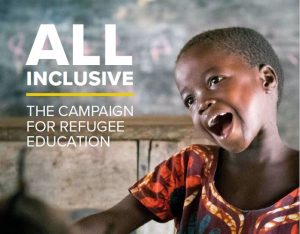Refugees struggle to access education – UN report
Access to education for displaced refugees is very limited compared to the general populations in their host countries, a new report from the UN refugee agency UNHCR has found.
Titled ‘All Inclusive: The Campaign for Refugee Education’, the report found that reported enrolment rates for refugee children globally in the 2021 academic year were 42 per cent at preschool, 68 per cent at primary level, 37 per cent at secondary level and 6 per cent in higher education, the report found,.
The report draws on data from more than 40 countries across the world, revealing the problematic state of refugee education – and illustrating how refugee children and youth are falling behind their non-refugee peers when it comes to access to an inclusive quality education.
In one case study, the report highlighted challenges in providing education for Sudanese refugees in Chad after nearly 4,000 new arrivals this year
Average class sizes in two schools in the Kouchagine-Moura camp, which hosts about 14,000 Sudanese refugees, have increased to more than 160 pupils, and the majority of classes are held outside due to lack of classroom space.
The report says that learning inequality disproportionately affects the most vulnerable – a problem that was exacerbated when the COVID-19 pandemic forced schools across the world to shut.
“Because 83 per cent of refugees and Venezuelans displaced abroad are hosted in low and middle-income countries, the potential consequences of this inequality are clear,” the report said.
 But the report’s data showed that given an opportunity, refugee students performed well.
But the report’s data showed that given an opportunity, refugee students performed well.
“Going by the measure of exam results, refugee students can point to a record of success. In 23 countries that reported results, 74 per cent of primary level refugee students passed national tests, while the figures for lower and upper secondary were 65 and 63 per cent respectively,” the report said.
“Of course, the numbers of refugees taking national tests is often very low – in Cameroon, for example, a pass rate of 74 per cent at lower secondary level is based on only 154 refugee students sitting the exams.
“But it does reinforce the point that where they get the opportunity, refugee students grasp it with both hands,” it said.
When it comes to taking exams, however, there is a clear gender imbalance.
“At primary level, of those refugee students who sat national tests in our reporting countries, only 39 per cent were girls. For lower and upper secondary level exams, the figures for girls were 44 and 43 per cent respectively,” the report said.
It said learning among refugee children and youth often takes place in a crowded environment and that data on teachers is patchy and very difficult to collect.
“A few countries have reported on teacher/pupil ratios in refugee communities – and the picture is one of hugely overcrowded classrooms, above recommended ratios, all of which has a negative impact on both teaching and learning experiences,” the report said.
“In eight countries across Sub-Saharan Africa, pupil per-teacher ratios were markedly higher for refugee children and youth than for nationals.
“In Burkina Faso, for instance, there were 40 national learners to every teacher, but for refugees that rose to 60:1. In Zimbabwe, the ratio for nationals was 36:1 but for refugees it was 59:1.
“In all cases, the classes were crowded enough to make effective teaching difficult – evidence both of the demand for education but also of the stresses and strains on capacity,” the report said.
But it said that while the number of refugees in higher education is very low, it has increased from 1 per cent a number of years ago to 3 per cent and now to 6 per cent.
Read the full report here: ‘All Inclusive: The Campaign for Refugee Education’












